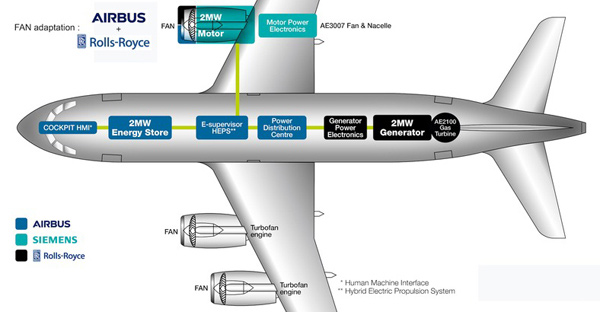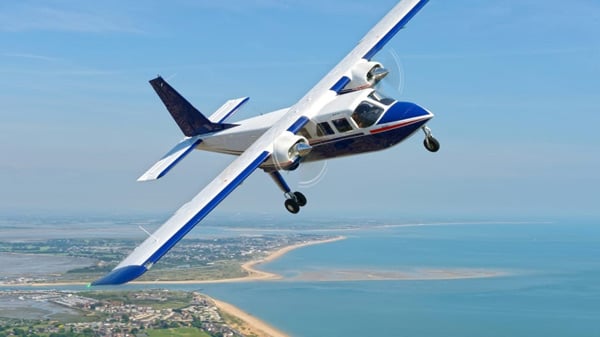Indeed, the future of electrical air travel in the UK is promising, but this shift will take time to materialise.
We’ve witnessed the rising popularity of hybrid and electric cars. These vehicles solve a growing emissions problem, but their range has been somewhat limited. EVs have accordingly been associated with shorter travel. At least in the early stages, our hybrid airplanes may not be so different.
New Partnerships and Planning
Electric air travel is the next big leap in commercial aviation: short-distance flights are the perfect testing grounds for emerging technologies. Aircraft manufacturers like EasyJet and Airbus have pledged to explore the viability of hybrid-electric flights. Related talks even date back to 2017, when EasyJet entered into a partnership with Wright Electric. Wright is actively developing a 100% electric short-range airliner.

A diagram of a hybrid aircraft, made possible by Airbus and other partners. Image credit: TreeHugger.
It’s worth noting that this transition—especially on a larger scale—will not be easy. This joint partnership primarily centres on research and development. Both CEOs have acknowledged electrical aviation’s unique technical challenges. There’s a huge amount of learning involved that will require time and resources.
Costs and Forecasting
One of clean energy’s biggest criticisms has been transitional costs, and every airline must weigh how economical these propulsion methods are. The savings in fuel costs are enticing, but it will be interesting to see if passenger fares will also be adequate (for example, EasyJet will imminently begin testing a nine-person aircraft).
Scaling this technology to massive airliners will be the biggest challenge. In fact, KLM CEO Pieter Elbers believes we won’t see fully electric airliners for another 15 to 20 years. EasyJet has nominated its own Amsterdam-London route as a possible testbed by 2027.
Companies will have to walk before they run. Cranfield Aerospace Solutions is planning to unveil a short-range, fully-electric aircraft by 2023. These planes will transport UK passengers on brief flights, while a low-emissions engine will help recharge the plane’s battery mid-flight. This is an ideal compromise with lessened environmental impact. These airliners will be converted Britten-Norman planes (an example of which is below) with small capacities.
The UK government is directly funding Cranfield’s project. This £9 million investment is a vote of confidence in the country’s commercial aircraft revolution. These proofs of concept are key to securing future support. A Cranfield University spokesperson pegged Scottish airline Loganair as a buyer for these new hybrid planes. Market interest is there and continually growing.

The Britten-Norman, a prime candidate for airplane hybridisation in the UK. Image Credit: Britten-Norman
Safety and Design Considerations
Flying is perhaps the safest form of travel we currently have available, and that’s no accident: every minutiae of air travel is regulated and held to stringent standards. As one could imagine, the introduction of new technology begets strong skepticism—especially in the realm of propulsion. These engines will be tested extensively to ensure they meet safety standards.
Of course, batteries are the lifeblood of hybrid-electric systems. They must be reliable, performant, and possess capacities large enough to support sustained travel. Auto manufacturers have received some flak for their irreparable hybrid designs. Aircraft manufacturers must find ways to simplify routine maintenance, should they borrow technologies from their EV predecessors.
The EU has funded a multinational group of universities and companies with the goal of creating a superconducting hybrid-electric motor. This prototype is expected to be ready for testing in 2020. The ASuMED Project’s ultimate goal is to produce a 99%-efficient motor without harmful emissions. This technology will certainly gain popularity if it performs well. A synchronous motor, advanced cooling systems, and specialised software tools unite to form a promising hybrid system.
As manufacturers continue to boost safety and efficiency, hybrid-electric aviation may very well exceed expectations in the near future.





